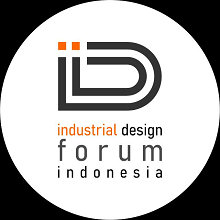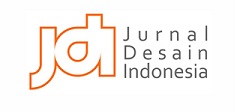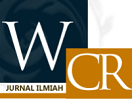PENGARUH PENGGUNAAN BINDER TERHADAP KEPEKATAN WARNA MENGGUNAKAN PIGMEN THERMOCROMIC LEUCO DYE PADA MATERIAL PRODUK FASHION KULIT (LEATHER)
Abstract
Thermochromic Dye is a substance that changes color due to temperature changes. Leuco Dye itself is a compound that is colorless or weakly colored, and reacts with the developer, to turn into a animate state. Thermocromic staining will experience a color change phenomenon when it receives a higher temperature change. The molecules contained in the substance will change into other color molecules when exposed to heat, but when the temperature drops again (cools down) the color changes again or looks transparent or another color. The application of a base coat in the finishing process is important because it greatly affects the physical properties of the skin. The materials used to make the base layer include binders, pigments, and solvents. The number of pigments and binders used in the finishing process varies, so the resulting skin has different qualities. This quality inconsistency is one of the problems in finishing the skin because there is no definite knowledge about the amount of binders and pigments that are applied to various types of skin. In the application of this color, of course, a binder is needed that is able to carry the croma substance attached to the material being applied. Thermocromic color pigment testing was carried out by comparing the use of protein and synthetic (acrylic) binder types in the leather material. With the treatment of cold and hot temperature discoloration, the result is that the use of acrylic binder experiences a constant change for ± 3 second / 10C a decrease in cold temperature in the slow reaction test, and a ± 5 second / 7.50 C increase in hot temperature in the slow reaction test. So that it shows colors at cold temperatures last longer at room temperature than colors at hot temperatures. While the use of protein binders shows a ± 5 second / 7.50C decrease in cold temperature in the slow reaction test and a ± 5 second / 7.50C increase in heat in the slow reaction test, but the color characters are not completely bound by the protein binder and still release the pigment to dust (dust), so the use of acrylic binders using acetone solvent is better than protein binders
Keywords
Full Text:
PDF (Bahasa Indonesia)References
Bamfield, P., & Hutchings, M. G. (2010). Chromic phenomena: technological applications of colour chemistry. 2nd ed. Cambridge: Royal Society of Chemistry.
Briggs, P. S. (1981). Gloving, Clothing and Special Leather. London: Tropical Products Institute.
Griyanitasari, G., Kasmudjiastuti, E., & Pidhatika, B. (2017). Pengaruh Variasi Pigmen Untuk lapisan Dasar (base coat) Pada Proses Finishing Terhadap Sifat Fisik Kulit Sapi. Buletin Peternakan, Vol. 41(3), 307-318.
Kulcar, R., Friškovec, M., Hauptman, N., Vesel, A., & Gunde, M. K. (2010) Colourimetric properties of reversible thermo-chromic printing inks. Journal Dye and Pigments Vol. 86(3), 271-277.
DOI: 10.1016/j.dyepig.2010.01.014. ISSN 01437208.
Moore, J. G. (2016). Fashion Fads Through American History: Fitting Clothes into Context. US: Greenwood.
Panak, O., Kashtalyan, K., & Syrovy, T. (Agustus, 2015). “Producing two component thermochromic pattern by means of offset printing”. Colour and Visual Computing Symposium (CVCS) (Agustus 25-26), pp. 1-5.
DOI: 10.1109/CVCS.2015.7274882.
Suryantari, R., & Flaviana, F. (2017). Aplikasi Thermochromic liquid crystal untuk mengamati perpindahan kalor pada permukaan logam. Indonesian Journal of Applied Physics, Vol. 7(1).
Salam, J. (2019). Eksplorasi Cetak Fotografi Vandyke Pada Material Kulit. NARADA Jurnal Desain dan Seni Vol. 6(3), 387- 400.
Salom, A., Candas, A., Zengin, A., & Bitslisli, B. O. (2016). Temperature Sensitive Colour Changing Leathers with Thermochromic Pigment. Journal Society of Leather Technologists And Chemists (SLTC) Vol. 100(6), 314-320.
Sumarni, S. (2013). Pengaruh Penggunaan Binder Gelatine Untuk Finishing Kulit Cakar Ayam Terhadap Ketahanan Gosok Cat Tutup. Berkala penelitian Teknologi Kulit, Sepatu, dan Produk Kulit vol. 12(2).
Vairaperumal, T., Kanadasan, D., Muthazhagan, R., Sreeram, K. J., Rao, J. R., & Nair, B. U. (2015). Thermochromism For Smart Leathers. Journal of the American Leather Chemists Association (JALCA) Vol 110(6), 161-164.
DOI: http://dx.doi.org/10.22441/narada.2021.v8.i2.005
Refbacks
- There are currently no refbacks.
Fakultas Desain dan Seni Kreatif
Universitas Mercu Buana
Gedung E Lantai 4
Jl. Raya Meruya Selatan no.1, Kembangan, Jakarta 11650
Tlp./Fax: +62215871335
Journal International Standard Serial Number (ISSN) Registration:
The Journal is indexed by:
Tools for Citations & Plagiarism Detection:

Ciptaan disebarluaskan di bawah Lisensi Creative Commons Atribusi-NonKomersial 4.0 Internasional
 NARADA: Jurnal Desain dan Seni
NARADA: Jurnal Desain dan Seni

























